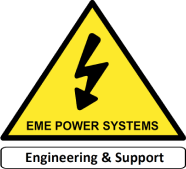Go Green and Save Pounds
Wednesday 4th October, 2017

Savings and carbon reduction from voltage optimised low loss transformers.
GO GREEN AND SAVE POUNDS
EME Power Systems are a leading installer of super low loss tier 2 transformers, reducing your carbon foot print and saving you thousands of pounds in low load and copper losses. We have been in discussions with local authorities sourcing government and EU funded grants to assist in helping small to medium companies reduce your carbon footprint and also save money on electricity consumption.
Depending on your company criteria a funded grant towards the cost of a new super low loss tier 2 transformer can reduce the purchase and install costs by in the region of 40%.
If you are interested in reducing your carbon footprint and saving on your electricty costs, or are looking at replacing an old transformer please read the following information below or alternatively phone 01529 410999 or email info@emepowersystems.co.uk to speak to the engineer responsible for your area.
Savings and Carbon Reduction from Voltage Optimised Low Loss Transformers
Why is this only relevant to high voltage metered consumers?
Our method of reducing the voltage involves changing your existing transformer for one fitted with tappings for a lower secondary voltage and therefore does not require the installation of additional equipment to your electrical system, and is usually significantly cheaper than the cost of an equivalently rated added on device.
One of our many transformer manufacturers currently produces a Tier 2 unit with the projected savings detailed below:
Savings based around a 1000kva 11000/415v super low loss unit:
Standard loss copper winding 1100/433 No Load (KW) 1350 Load (KW) 12,500
Super low loss Aluminium winding 11000/415 No Load (KW) 500 Load (KW) 6530
Potential Energy Savings @ 70% Load and 0.85 pence per KWHr
Annual KWHr Saving 33000
Annual Co2 Emission Reduction (Tonnes) 14.69
Annual Savings £2,800.00
Other benefits include:
8-10% average electricity savings
No-load losses reduced by up to 75%
Guaranteed loss savings (typically £2500 /year)
Payback from 5 months to 2.5 years
Lowest combined transformer losses: cut by up to 50%
Cost effective VO solution
Eligible for Energy Efficiency Finance from Carbon Trust
How Do I Progress Things Further?
In the first instance please give me a call; from an initial telephone conversation we should be able to gauge an approximation of how much the required work would cost, give an outline estimate of potential savings and then form an idea of the payback period: EME Power Systems can then produce a fully costed scope of works ready for your approval.
Savings and Carbon Reduction from Voltage Optimised Low Loss Tier 2 Transformers.
How Much Can We Expect To Save?
The savings will vary depending on a number of factors (types of load installed, existing supply voltage etc.). Companies that have already deployed voltage optimising techniques are reporting savings as high as 8 - 10 %.
How much lower will our operating voltage be?
The UK standardised supply voltage tolerances are 400 Volts -6%, +10%. BERR (the Department for Business Enterprise and Regulatory Reform, successor to the DTI) has confirmed this will remain the UK position until further notice. This means that in theory a site supplied at low voltage direct from the local distribution network could legitimately be supplied at 376 Volts; as a consequence all electrical equipment must be designed to operate between 376 Volts and 440 Volts. The actual target voltage to be aimed for would be dependent on a site survey, discussions with the end user and would most likely be set at about 385 Volts.
What Do I Need to Do to Take Advantage of This?
It is usually a straightforward job to change any of your existing transformers for a new one that is capable of providing a lower secondary voltage. As a reputable High Voltage Electrical Contractor we would be happy to provide you with costed proposals for carrying out the necessary work.
We are not introducing additional equipment into the distribution system and so substation capacity is not restricted and there are no additional ownership or maintenance costs to be incurred.
News Stories
- Benefits of Furans Testing
- Aftermath of Storm Babet
- Emergency Response to Storm Babet’s Disruption
- Welcoming Samantha Collishaw and Reducing Carbon Footprint
- Ardagh Glass Transformer Replacement
- Considering Voltage Management to Help Cut Bills?
- Graham Haydn-Davies Retirement
- LV Sub-Main Fault
- Cable Joint Failure
- Phil Shaw Retirement
- Directional Drilling
- Pre-Planned Maintenance
- Energy Savings Factsheet
- The Benefits of Carrying Out Planned Preventative Maintenance (PPM)
- EME Transformer Stock Saves the Day!
- PARTIAL DISCHARGE TESTING
- Storm Franklyn
- Helping to Mitigate the UK Energy Crisis
- EME Power Systems Helps Company To Join The Recycling Effort
- Christmas Time Switchgear Changes
- Out of Hours Peace of Mind
- EME Power Systems Fast Response for Major Food Manufacture
- Importance of Regular Intrusive Maintenance
- NHS Challenge
- Automated Packaging at Malvern Worcestershire
- Christmas Arrives Early
- Challenge Accepted
- Through these uncertain times...
- Hayley Paddock Joins EME Power Systems
- Challenging Times
- Low Carbon Electricity
- Our excellent installation teams complete essential works
- Fast Response
- Essential Maintenance
- Solution to a tricky transformer replacement
- It's A Cut!
- EME Power Systems Quarterly Update
- Infrastructure Upgrade
- EME Power Systems Continue As Normal
- It's Cold Inside
- Double transformer failure leads to double success
- Steve Harrison Joins the Company
- Class Cancelled
- Now For Something Slightly Different
- Cable Fault Repair
- ACB
- Time For A Quick Change Around
- Lincoln Prison
- EME Power Systems Renewables
- An Early Summer Break - Out With The Old, In With The New
- EME Power Systems Midweek Break
